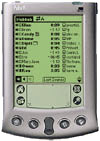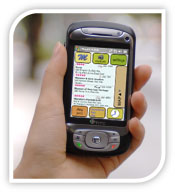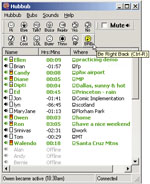Research Interests
Most of my research has been in the broad areas of mobile systems, collaboration, and communication, although recently I have been exploring technologies to support services, such as urban parking and nursing. While doing design and evaluation work, I've used a variety of methods to observe users, sometimes to understand their underlying needs before designing a technology and sometimes to refine and iterate on a design as the technology is being developed. As part of this process, I developed a tutorial on ways to interview customers to understand their underlying requirements for technology.
Mobile Systems
 In the early days of mobile devices, I conceived of and designed a research prototype sytem called Hubbub that allowed people to use a wireless Palm PDA to stay aware of others and to instant message with them. We saw some early examples of people using mobile devices to handle issues in context and simply to maintain awareness of others while out and about. We found that supporting mobility meant not just providing software for a mobile device but also enabling a smooth transition to other computers at home, work, and elsewhere. [Read more about Hubbub.]
In the early days of mobile devices, I conceived of and designed a research prototype sytem called Hubbub that allowed people to use a wireless Palm PDA to stay aware of others and to instant message with them. We saw some early examples of people using mobile devices to handle issues in context and simply to maintain awareness of others while out and about. We found that supporting mobility meant not just providing software for a mobile device but also enabling a smooth transition to other computers at home, work, and elsewhere. [Read more about Hubbub.]
 More recently I've conducted studies observing people while mobile. In one study, we video shadowed small groups of friends and family to see how they stayed connected both when apart and together. We found, among other things, that despite the multitude of technologies available to support communication, there is no easy way for small groups to connect when some people are co-located and some are remote. Instead, people were creative in combining multiple communication channels to maintain group connectivity, a phenomenon we call cross-channeling.
More recently I've conducted studies observing people while mobile. In one study, we video shadowed small groups of friends and family to see how they stayed connected both when apart and together. We found, among other things, that despite the multitude of technologies available to support communication, there is no easy way for small groups to connect when some people are co-located and some are remote. Instead, people were creative in combining multiple communication channels to maintain group connectivity, a phenomenon we call cross-channeling.
In another study, I evaluated a mobile recommender of leisure activities called Magitti. I found that people loved being able to easily discover new places to go as they walked around a downtown area, quickly browsing reviews and user comments and locating recommended venues on a map. But the system needed improvement in a few areas. For example, people needed more help in narrowing down a list to make a selection, and they sometimes found it difficult to get back to a item since the list kept changing as they walked along. It was also difficult for people to share the experience with others, since mobile devices are inherently single-user systems. [Read more about Magitti.]
I also helped design and conduct a study to understand how the people's context affects their receptivity to content on their mobile phones, looking especially at the difference between pushing content to people and letting them pull content. In this iGo study, we found that machine models did poorly when predicting receptivity to content based on contextual factors (location, activity, time, setting, etc.) even when we knew the person's level of interest in the content. However, if given an incentive people will request content frequently and in a wide variety of contexts. People were most likely to request content during microwaiting moments -- short periods of idle time, either in between or in the middle of other ongoing activities. The variety of microwaiting moments was vast; people requested content in between workout sets, while waiting for a parking space, while simmering onions, while waiting for files to download, while waiting for a doctor to return to an exam room, and while pumping gas, just to name a few in the long list of microwaiting moments. People were also more open to "seeing what they got" compared with those who had content pushed at them, since they were idle and looking to fill the time. [Read more about the iGo study.]
Awareness, Collaboration and Communication

I've long been interested in systems that enable people who are in different locations to maintain a background awareness of one another and to communicate in lightweight ways. While at Sun in the early 1990s, I worked on a prototype desktop video conferencing system called Montage that made it easy for people to "video glance" into their colleague's offices and use the visual channel to smoothly negotiate a good time to interact, much as they do in face-to-face settings. If so, either party could enable the audio and engage in a full-scale audio-video interaction. [Read more about Montage.]
 During that time I also designed a tool for giving video-based presentations over the network, called Forum. Audiences could watch a speaker giving a live talk from their computers, follow along with the slides, ask voice and text questions, and answer poll questions posed by the speaker. While building the system, we hosted dozens of talks, each time observing speakers and audience members and refining the design to make it easier to use and more tuned to participants' needs. [Read more about Forum.]
During that time I also designed a tool for giving video-based presentations over the network, called Forum. Audiences could watch a speaker giving a live talk from their computers, follow along with the slides, ask voice and text questions, and answer poll questions posed by the speaker. While building the system, we hosted dozens of talks, each time observing speakers and audience members and refining the design to make it easier to use and more tuned to participants' needs. [Read more about Forum.]
 While at AT&T during the early 2000s I worked with a small team to build Hubbub, an instant messenger designed to enable people to maintain a background awareness of one another even when they weren't actively messaging each other. Again, we conducted a long-term user study while building the system and saw the subtle but powerful benefits of enabling people across the country to stay aware of each other's activities, bridging time-zone gaps and enabling impromptu conversations that are typically lacking among distributed groups. In our observations, we saw that people used the location field as a kind of status update area and so we expanded it and made it more prominent. In retrospect, this observation foreshadowed the popularity of the status update functions provided by Twitter, Facebook and other social networking sites. As part of the Hubbub study, we also collected thousands of examples of instant messages and did a detailed analysis of the types of interactions that occurred over IM in a workplace setting. [Read the instant messaging analysis.]
While at AT&T during the early 2000s I worked with a small team to build Hubbub, an instant messenger designed to enable people to maintain a background awareness of one another even when they weren't actively messaging each other. Again, we conducted a long-term user study while building the system and saw the subtle but powerful benefits of enabling people across the country to stay aware of each other's activities, bridging time-zone gaps and enabling impromptu conversations that are typically lacking among distributed groups. In our observations, we saw that people used the location field as a kind of status update area and so we expanded it and made it more prominent. In retrospect, this observation foreshadowed the popularity of the status update functions provided by Twitter, Facebook and other social networking sites. As part of the Hubbub study, we also collected thousands of examples of instant messages and did a detailed analysis of the types of interactions that occurred over IM in a workplace setting. [Read the instant messaging analysis.]
Understanding Customer's Needs
As part of my research designing and studying the use of technology, I have had many occasions to go into the field to observe and interview people who are carrying out the activities we hope to support with technology. Although the temptation is simply to ask people what they want, that approach can be misleading and misses opportunities to discover needs that people aren't aware of or can't articulate. While at Sun, I created a tutorial that teaches some of the techniques I've used to elicit underlying needs for technology support. That turned into a one-day course that I've given at conferences and at companies such as Bose, GE Healthcare, WRQ, Interval, and others.
